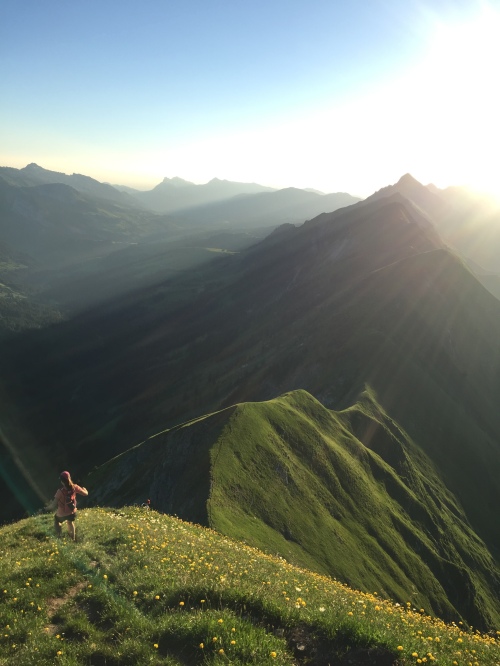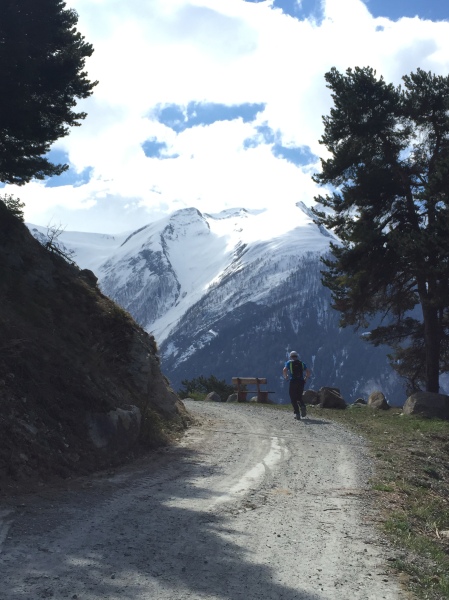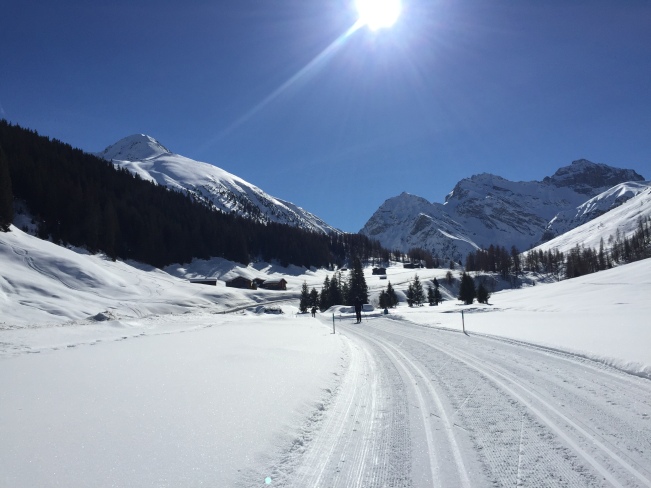
I’ve spent the last month not working, and it has been fantastic.
It was such a huge push to defend my PhD, and then I had a few more months of work at Eawag, trying to finish up projects and papers. I wanted to make sure to take some time to myself before starting a postdoc, because I’m not sure when I’ll have another chance to just completely unplug. Science moves fast and as soon as I start my postdoc, I’ll be applying for jobs all over again.
“That’s great!” People would say when I told them I was taking the summer off. “What will you do with yourself?”
“Well, a lot of hiking, sleeping late, and reading,” I’d say. “And in July I’m doing my first real mountain running race.”
Thinking back, I have realized that the race – the Gran Trail Courmayeur 30 k – isn’t really my first mountain trail race at all.
Last year I did a trail marathon, the Transruinaulta, with 6,000 feet of climbing (and descending). Does that not count?
In 2016, I did a trail half marathon that went straight up a downhill ski resort in Arosa, Switzerland, for 4,000 feet of climbing (and descending). Does that not count?
What about all the times before, during and after college that I time trialed up Mount Moosilauke in New Hampshire? Or participated in the Presidential Ridge Relay Race?
Those were all, in fact, mountain running races. Especially the one in Arosa. But I for some reason didn’t consider them to be my “real” mountain running debut, probably for two reasons.
One was that maybe I wanted to be ready for that debut, to have prepared, to train, to take it seriously. I didn’t do that before Arosa, I just signed up and figured I was a cross-country skier so I’d be fine. Now, I’ve been preparing.
And the second one was maybe because, having lived in Europe for a while, I have this picture in my head of a mountain running race, with singletrack trail and glaciers in the background. I think in my mind my mountain running debut had to fit that image. And Arosa… it was up a ski resort. It didn’t feel so wild. Transruinaulta was as much on dirt roads as trails. Moosilauke, you only race up, not down.
Whether it was my “first real mountain race” or not, Gran Trail Courmayeur is in the books. It was awesome, and I’m excited to explore the mountain/trail race scene in North America after this intro from the Alps.
I had never really been to the Mont Blanc area, so went down the Thursday before my Saturday race. It was amazing to see this huge mountain, and so much ice crammed up in there. I’ve seen glaciers running into the ocean, glaciers filling valleys in the Alps, shrinking and sad-looking patches of glacier on mountainsides. But the amount of ice just perched up there, literally hanging off the side of the mountain, blew my mind.
I wanted to just look at it, to soak it in. What a cool place.
The Friday, I didn’t know what to do with myself – I wanted to explore, but didn’t want to get tired. So I splurged and took an expensive cablecar ride up to Punta Helbronner, 3,466 meters high and looking over at Mont Blanc.
Well, where Mont Blanc should be. It was covered in clouds.

The highest peak in Europe west of the Caucasus is back in there, somewhere.

View in the other direction was pretty nice though. (click to expand)
But being up there sure was amazing, and seeing ant-like figures trekking across the snowfields. I kind of couldn’t believe I was in Europe, and that the hot valley floor was just a few minutes cablecar ride away.

An aerial view down on the Rifugio Torino and onwards to my racecourse, over around and past the green ridge in the center of the photo.
Then, I went to the sports center to pick up my number. The race organization was typically Italian: everything worked out perfectly in the end, but it was very confusing. For example, I had studied the course map trying to figure out where the start/finish would be. It appeared to be in the middle of town, but on my way past, I hadn’t seen anything you’d expect for a race starting in just 12 hours.

The line to pick up our numbers; race officials had to check our medical certificates to make sure a doctor had said we could participate in such an event without dying. This is a common requirement for races in Italy and France, but explaining the request to a Swiss doctor was interesting. Also – do you see many women in this line? sigh.
“The race start is not here, it is somewhere else, is that correct?” I asked the woman who handed me my number.
“The start and finish are here,” she said, looking at me like I was crazy.
“Oh, really? Here?”
“Yes, down, outside, with the big arch!”
Okay, so I’d have to subtract two kilometers from everything on the course map/profile, because they seemed to be using the same loop as the map on their website [I assumed], but moving where the loop started and ended. Makes total sense.
I’m a pretty organized person, and I’m also a nerd, and I also worry a lot. At races like this, it can be challenging for me to prepare because I want to have a detailed plan of exactly how the race was going to go. This sort of uncertainty didn’t help.
I pored over the course map, sussing out how the 1,800 meters (6,000+ feet) of elevation gain and loss were distributed around the course. One big climb in the beginning. Then a flat that I doubted was actually flat, for six kilometers. Then a second major climb. A drop down to a valley, a shorter steep climb, and then all downhill from there. Steeply.
And I checked the finishing times from the previous year, trying to estimate how long the race would take me. Four hours? Five? It all depended on the trail. And whether there would be any other surprises in store for me along the way.
The next morning I hurried down from our AirBnB to get to the start, because it was written that we had to enter the start pen 30 minutes before the start, and then they would close it. Well, the start pen didn’t even open until 20 minutes til start time, and then it stayed open. Again, classic Italy.

Once the race began, though, everything was perfectly organized. We ran through neighborhoods out of town, with people cheering along the sides of the road. After two kilometers or so, we joined the Tour de Mont Blanc (TMB) trail and climbed upward: about two and a half kilometers of an average 25% grade.
This part of the race was a hiking race, and it felt a little bit silly to be hiking. The trail was crowded with hikers carrying backpacks big and small: tourists out for a day hike, or folks backpacking the whole TMB loop. We were sure moving faster than them, but we must have looked ridiculous.
I tried to stay at a steady pace, below my anaerobic threshold, and just climb away. By the top my legs were aching a bit, nothing major, but reminding me that although I had only been going for an hour, I’d already put in more than 2,500 feet of the course’s elevation.
We passed through the first aid station, then crested a pass. We had just been climbing straight up, and my eyes had been glued to the trail in front of me. But suddenly, there was no trail or hill in front of me.
Just the Mont Blanc massif in all its glory, basking a bit in the sun. Everyone around me paused and took out their phones for pictures. It was just amazing.

I really, really don’t usually stop to take photos in races. But this was such a scene, and everyone else around me was stopping to take pictures too. So I did.
That feeling, that image I had been looking for for my “first real mountain race”? As we set off on the singletrack along the Balcon de Ferret, I definitely had it. This was it. This was the stuff of dreams and legends. I was there and I was doing it.
As I had expected, the Balcon wasn’t actually flat. But for the most part, it was runnable, and a really fun trail.

There were a few guys around me and we cruised along. I felt better, like I was in a running race after all. The views were continually astounding, and every once in a while there would be hikers pulling off the trail or having stopped for a snack in an alpine meadow who would cheer us along.

“Brava!” they would shout as I passed. I wasn’t sure how many women were ahead of me, but there were few women in the field (just under a third of the entrants in the 30 k were women), and so seeing me among the sea of men was probably still notable no matter how many women were faster.
Before long, we ran out of Balcon and turned right up a steep hill. This was the start of the second big climb, and its beginning was a doozy, a shock after the easy kilometers we had been lulled into. Here there were even more spectators, because there was a hut up ahead where they were probably planning to have lunch.
We climbed for a while, and then the trail leveled off into a broad bowl-like meadow valley. Looking ahead, all you could see was mountain.
You might want to stay in such a nice, welcoming, pleasant spot. But we couldn’t. After a dissapointingly short flat section, up we went, steeply again, to the top of the second major climb.

And here I got my first surprise of the race. It had nothing to do with the organizers; it had to do with me. I wasn’t feeling strong exactly, and I was struggling to eat (not because of stomach issues, but on a hot day my food just didn’t seem appealing). And yet, I began to catch people who had hiked away from me on the first climb.
On these big hills, you can see everyone spread out way ahead of you, and I watched in amazement as I came ever closer to two women whom I hadn’t seen in over an hour.
“Don’t get too excited,” I tried to tell myself. “There’s a lot of race left. You could still blow up and they could pass you back. Just be careful and do a good job.”
But on the downhill to the next valley, I put distance on them (and passed some men, too). The “last” steep climb up to the final pass felt terrible, and my legs were screaming. For sure they’ll catch me, I thought. But they didn’t. In fact, I was catching more men, and another woman. Again, I was amazed. I didn’t feel strong.

The last pass!
And then, the big downhill. This was my second surprise.
I love downhill. Maybe it’s because I’m a skier, but running downhill is just fun. I’m pretty confident in my footwork, and I know that it’s easier to zoom than it is to be braking all the time and put so much stress on your quads and knees. I had dreamed of this downhill for kilometers. I was going to fly. My resolution: I wouldn’t let myself be passed by any woman.
Somehow, I had failed to completely account for the magnitude of this downhill. We had eight kilometers to lose 1,300 meters of elevation, and there were 150 or so meters of climbing thrown in there too. So on average, the grade was more than 15%. That’s steep. We classify “A” and “B” climbs in skiing, categorize climbs in bike racing, etc etc… but we don’t classify descents.
The beginning of this descent was unreal. Loose dirt, incredibly steep. I found myself taking tiny steps, putting on the brakes, terrified of sliding out and falling down the mountain. I was not zooming. I wouldn’t be at the finish line as soon as I had hoped, that much was clear.
And my concern was justified. A few kilometers later, I heard a terrible scream. I couldn’t place it – somewhere in front of me, but was it a person? An animal? Was it a racer, or a bystander, maybe a kid? I ran on, and eventually came across a few male runners stopped on the side of the trail. Ten feet down the side of the mountains, someone was moaning and trying to climb out of the brush and the forest. It was a racer down there, who must have tripped and fell over the edge. One of the men was on a cell phone calling for help.
“Is there anything I can do?” I asked.
“I guess you can go on,” one of them said. Not speaking Italian, I did doubt how useful I would be in helping this poor person, but as I ran on, it also felt wrong to leave.
When we reached the next aid station, the men I was following explained more to the volunteers about the injured runner. They were setting off to go assist.
I sucked on an orange slice, glad for the new option for sugar delivery. I was thirsty and knew I should eat more, but the downhill pounding and the heat made doing so very unattractive. Oranges, though? Perfect. I started running again.
Although I was so much more tentative on the downhills than I expected to be, I still passed quite a few people. No more women, after that, but some men. There were sections of trail that were less steep, or just more even, and there I could fly.
That’s what I thought, until a woman with a long braid went sailing past me. Shewas flying. I hadn’t even known what flying was. It was instantly clear that I could not keep up with her. My resolution was broken. I have to practice downhills before my next race, I guess.
We eventually hit a paved road and dropped down into town, across the river, and back towards the sports center and the finish. There weren’t many signs or markings through town; roads weren’t closed; people were watching, but they didn’t have any clues about what was happening. I had expected an adrenaline rush, but mostly, the tourists were just going about their day and we were some weird sideshow that they barely noticed.

The final 10 meters of climbing leading up to the finish line were brutal, and I felt I couldn’t push at all. I crossed the finish line exhausted, but happy, and took off my sunglasses and smiled big for the finish line photographer.

I had done my first “real” mountain race, or my second or third or or eighth mountain race. Who cares? It had been fun and brutal, which are two things I had been counting on. The trail had been technical – if 4:30 (my final time) seems slow for a 28 k race, the actual trail was a big part of that, besides the up and down.
I had felt okay, but most importantly, I had felt like I belonged there. I was running and hiking with people who obviously trained for this, but we also all had fun enjoying the spectacular scenery. The atmosphere and camaraderie were fantastic, a great combination of serious sport and doing this because we actually enjoy being in the mountains.
And I had finished ninth. I don’t know what top ten means in this field, and that’s actually something I love about racing in new places. I didn’t know a single person there, so my analytical mind couldn’t really consider whether that’s a good or bad or respectable result. A whole exhausting, self-defeating doom loop I could just skip. But top-10 always has a nice ring to it.
The next day it was a long trip back to Zurich, during which I read almost an entire book. Since I’m on vacation, I could recover on the sofa at home in the next few days, rather than dragging my tired body around at work and trying to make my tired brain be smart.
Instead of working, I’ve been dreaming up what my next adventures will be.

It’s Italy so… post-race (and post-shower!) aperitivo!








































































